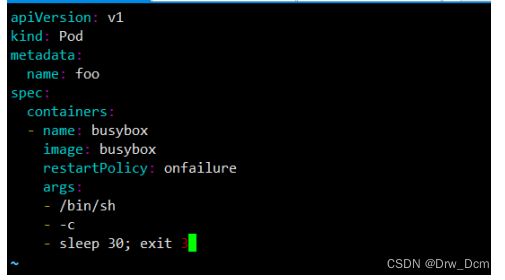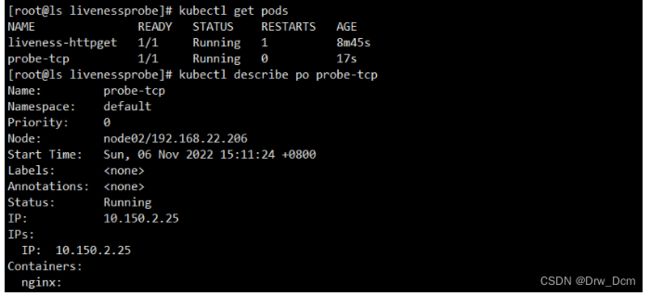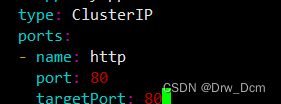Pod进阶
目录
一、资源限制
1.CPU 资源单位
2.内存资源单位
二、重启策略(restartPolicy)
三、健康检查
1.探针的三种规则
2.Probe三种检查方法
一、资源限制
当定义 Pod 时可以选择性地为每个容器设定所需要的资源数量。 最常见的可设定资源是 CPU 和内存大小,以及其他类型的资源。
当为 Pod 中的容器指定了 request 资源时,调度器就使用该信息来决定将 Pod 调度到哪个节点上。当还为容器指定了 limit 资源时,kubelet 就会确保运行的容器不会使用超出所设的 limit 资源量。kubelet 还会为容器预留所设的 request 资源量, 供该容器使用。
如果 Pod 运行所在的节点具有足够的可用资源,容器可以使用超出所设置的 request 资源量。不过,容器不可以使用超出所设置的 limit 资源量。
如果给容器设置了内存的 limit 值,但未设置内存的 request 值,Kubernetes 会自动为其设置与内存 limit 相匹配的 request 值。 类似的,如果给容器设置了 CPU 的 limit 值但未设置 CPU 的 request 值,则 Kubernetes 自动为其设置 CPU 的 request 值 并使之与 CPU 的 limit 值匹配。
官网示例:
https://kubernetes.io/docs/concepts/configuration/manage-compute-resources-container/
Pod 和 容器 的资源请求和限制
spec.containers[].resources.requests.cpu 定义创建容器时预分配的CPU资源
spec.containers[].resources.requests.memory 定义创建容器时预分配的内存资源
spec.containers[].resources.limits.cpu 定义 cpu 的资源上限
spec.containers[].resources.limits.memory 定义内存的资源上限1.CPU 资源单位
CPU 资源的 request 和 limit 以 cpu 为单位。Kubernetes 中的一个 cpu 相当于1个 vCPU(1个超线程)。
Kubernetes 也支持带小数 CPU 的请求。spec.containers[].resources.requests.cpu 为 0.5 的容器能够获得一个 cpu 的一半 CPU 资源(类似于Cgroup对CPU资源的时间分片)。表达式 0.1 等价于表达式 100m(毫核),表示每 1000 毫秒内容器可以使用的 CPU 时间总量为 0.1*1000 毫秒。
Kubernetes 不允许设置精度小于 1m 的 CPU 资源。
2.内存资源单位
内存的 request 和 limit 以字节为单位。可以以整数表示,或者以10为底数的指数的单位(E、P、T、G、M、K)来表示, 或者以2为底数的指数的单位(Ei、Pi、Ti、Gi、Mi、Ki)来表示。
如:1KB=10^3=1000,1MB=10^6=1000000=1000KB,1GB=10^9=1000000000=1000MB
1KiB=2^10=1024,1MiB=2^20=1048576=1024KiB
apiVersion: v1
kind: Pod
metadata:
name: frontend
spec:
containers:
- name: app
image: images.my-company.example/app:v4
env:
- name: MYSQL_ROOT_PASSWORD
value: "password"
resources:
requests:
memory: "64Mi"
cpu: "250m"
limits:
memory: "128Mi"
cpu: "500m"
- name: log-aggregator
image: images.my-company.example/log-aggregator:v6
resources:
requests:
memory: "64Mi"
cpu: "250m"
limits:
memory: "128Mi"
cpu: "500m"Pod 有两个容器,每个容器的 request 值为 0.25 cpu 和 64MiB 内存,每个容器的 limit 值为 0.5 cpu 和 128MiB 内存。那么可以认为该 Pod 的总的资源 request 为 0.5 cpu 和 128 MiB 内存,总的资源 limit 为 1 cpu 和 256MiB 内存。
vim pod2.yaml
apiVersion: v1
kind: Pod
metadata:
name: frontend
spec:
containers:
- name: web
image: nginx
env:
- name: WEB_ROOT_PASSWORD
value: "password"
resources:
requests:
memory: "64Mi"
cpu: "250m"
limits:
memory: "128Mi"
cpu: "500m"
- name: db
image: mysql
env:
- name: MYSQL_ROOT_PASSWORD
value: "abc123"
resources:
requests:
memory: "512Mi"
cpu: "0.5"
limits:
memory: "1Gi"
cpu: "1"
kubectl apply -f pod2.yaml
kubectl describe pod frontend
kubectl get pods -o wide
kubectl describe nodes node02 由于当前虚拟机有2个CPU,所以Pod的CPU Limits一共占用了50%
二、重启策略(restartPolicy)
当 Pod 中的容器退出时通过节点上的 kubelet 重启容器。适用于 Pod 中的所有容器。
1)Always:当容器终止退出后,总是重启容器,默认策略
2)OnFailure:当容器异常退出(退出状态码非0)时,重启容器;正常退出则不重启容器
3)Never:当容器终止退出,从不重启容器。
K8S 中不支持重启 Pod 资源,只有删除重建
vim pod3.yaml
apiVersion: v1
kind: Pod
metadata:
name: foo
spec:
containers:
- name: busybox
image: busybox
args:
- /bin/sh
- -c
- sleep 30; exit 3
kubectl apply -f pod3.yaml![]()
查看Pod状态,等容器启动后30秒后执行exit退出进程进入error状态,就会重启次数加1
kubectl get pods
kubectl delete -f pod3.yaml
vim pod3.yaml
apiVersion: v1
kind: Pod
metadata:
name: foo
spec:
containers:
- name: busybox
image: busybox
args:
- /bin/sh
- -c
- sleep 30; exit 3
restartPolicy: Never
注意:和container同一个级别
kubectl apply -f pod3.yaml容器进入error状态不会进行重启
kubectl get pods -w![]()
![]()
三、健康检查
又称为探针(Probe)
探针是由kubelet对容器执行的定期诊断。
1.探针的三种规则
1)livenessProbe :判断容器是否正在运行。如果探测失败,则kubelet会杀死容器,并且容器将根据 restartPolicy 来设置 Pod 状态。 如果容器不提供存活探针,则默认状态为Success。
2)readinessProbe :判断容器是否准备好接受请求。如果探测失败,端点控制器将从与 Pod 匹配的所有 service endpoints 中剔除删除该Pod的IP地址。 初始延迟之前的就绪状态默认为Failure。如果容器不提供就绪探针,则默认状态为Success。
3)startupProbe(这个1.17版本增加的):判断容器内的应用程序是否已启动,主要针对于不能确定具体启动时间的应用。如果配置了 startupProbe 探测,在则在 startupProbe 状态为 Success 之前,其他所有探针都处于无效状态,直到它成功后其他探针才起作用。 如果 startupProbe 失败,kubelet 将杀死容器,容器将根据 restartPolicy 来重启。如果容器没有配置 startupProbe, 则默认状态为 Success。
注:以上规则可以同时定义。在readinessProbe检测成功之前,Pod的running状态是不会变成ready状态的。
2.Probe三种检查方法
1)exec :在容器内执行指定命令。如果命令退出时返回码为0则认为诊断成功。
2)tcpSocket :对指定端口上的容器的IP地址进行TCP检查(三次握手)。如果端口打开,则诊断被认为是成功的。
3)httpGet :对指定的端口和路径上的容器的IP地址执行HTTPGet请求。如果响应的状态码大于等于200且小于400,则诊断被认为是成功的
每次探测都将获得以下三种结果之一:
成功:容器通过了诊断。
失败:容器未通过诊断。
未知:诊断失败,因此不会采取任何行动
官网示例:
https://kubernetes.io/docs/tasks/configure-pod-container/configure-liveness-readiness-startup-probes/
exec方式
apiVersion: v1
kind: Pod
metadata:
labels:
test: liveness
name: liveness-exec
spec:
containers:
- name: liveness
image: k8s.gcr.io/busybox
args:
- /bin/sh
- -c
- touch /tmp/healthy; sleep 30; rm -rf /tmp/healthy; sleep 60
livenessProbe:
exec:
command:
- cat
- /tmp/healthy
failureThreshold: 1
initialDelaySeconds: 5
periodSeconds: 5initialDelaySeconds:指定 kubelet
在执行第一次探测前应该等待5秒,即第一次探测是在容器启动后的第6秒才开始执行。默认是 0 秒,最小值是 0。
periodSeconds:指定了 kubelet 应该每 5 秒执行一次存活探测。默认是 10 秒。最小值是 1。
failureThreshold: 当探测失败时,Kubernetes 将在放弃之前重试的次数。 存活探测情况下的放弃就意味着重新启动容器。就绪探测情况下的放弃 Pod 会被打上未就绪(0/1)的标签。默认值是 3。最小值是 1。
timeoutSeconds:探测的超时后等待多少秒。默认值是 1 秒。最小值是 1。(在 Kubernetes 1.20 版本之前,exec 探针会忽略 timeoutSeconds 探针会无限期地 持续运行,甚至可能超过所配置的限期,直到返回结果为止。)
可以看到 Pod 中只有一个容器。kubelet 在执行第一次探测前需要等待 5 秒,kubelet 会每 5 秒执行一次存活探测。kubelet 在容器内执行命令 cat /tmp/healthy 来进行探测。如果命令执行成功并且返回值为 0,kubelet 就会认为这个容器是健康存活的。 当到达第 31 秒时,这个命令返回非 0 值,kubelet 会杀死这个容器并重新启动它。
vim exec.yaml
apiVersion: v1
kind: Pod
metadata:
name: liveness-exec
namespace: default
spec:
containers:
- name: liveness-exec-container
image: busybox
imagePullPolicy: IfNotPresent
command: ["/bin/sh","-c","touch /tmp/live ; sleep 30; rm -rf /tmp/live; sleep 3600"]
livenessProbe:
exec:
command: ["test","-e","/tmp/live"]
initialDelaySeconds: 1
periodSeconds: 3
kubectl create -f exec.yaml
kubectl describe pods liveness-exec
kubectl get pods -w
httpGet方式
apiVersion: v1
kind: Pod
metadata:
labels:
test: liveness
name: liveness-http
spec:
containers:
- name: liveness
image: k8s.gcr.io/liveness
args:
- /server
livenessProbe:
httpGet:
path: /healthz
port: 8080
httpHeaders:
- name: Custom-Header
value: Awesome
initialDelaySeconds: 3
periodSeconds: 3在这个配置文件中,可以看到 Pod 也只有一个容器。initialDelaySeconds 字段告诉 kubelet 在执行第一次探测前应该等待 3 秒。periodSeconds 字段指定了 kubelet 每隔 3 秒执行一次存活探测。kubelet 会向容器内运行的服务(服务会监听 8080 端口)发送一个 HTTP GET 请求来执行探测。如果服务器上 /healthz 路径下的处理程序返回成功代码,则 kubelet 认为容器是健康存活的。如果处理程序返回失败代码,则 kubelet 会杀死这个容器并且重新启动它。
任何大于或等于 200 并且小于 400 的返回代码标示成功,其它返回代码都标示失败。
vim httpget.yaml
apiVersion: v1
kind: Pod
metadata:
name: liveness-httpget
namespace: default
spec:
containers:
- name: liveness-httpget-container
image: soscscs/myapp:v1
imagePullPolicy: IfNotPresent
ports:
- name: http
containerPort: 80
livenessProbe:
httpGet:
port: http
path: /index.html
initialDelaySeconds: 1
periodSeconds: 3
timeoutSeconds: 10
kubectl create -f httpget.yaml
kubectl exec -it liveness-httpget -- rm -rf /usr/share/nginx/html/index.html
kubectl get pods
tcpSocket方式
apiVersion: v1
kind: Pod
metadata:
name: goproxy
labels:
app: goproxy
spec:
containers:
- name: goproxy
image: k8s.gcr.io/goproxy:0.1
ports:
- containerPort: 8080
readinessProbe:
tcpSocket:
port: 8080
initialDelaySeconds: 5
periodSeconds: 10
livenessProbe:
tcpSocket:
port: 8080
initialDelaySeconds: 15
periodSeconds: 20 同时使用 readinessProbe 和 livenessProbe 探测。kubelet 会在容器启动 5 秒后发送第一个 readinessProbe 探测。这会尝试连接 goproxy 容器的 8080 端口。如果探测成功,kubelet 将继续每隔 10 秒运行一次检测。除了 readinessProbe 探测,这个配置包括了一个 livenessProbe 探测。kubelet 会在容器启动 15 秒后进行第一次 livenessProbe 探测。就像 readinessProbe 探测一样,会尝试连接 goproxy 容器的 8080 端口。如果 livenessProbe 探测失败,这个容器会被重新启动。
vim tcpsocket.yaml
apiVersion: v1
kind: Pod
metadata:
name: probe-tcp
spec:
containers:
- name: nginx
image: soscscs/myapp:v1
livenessProbe:
initialDelaySeconds: 5
timeoutSeconds: 1
tcpSocket:
port: 8080
periodSeconds: 10
failureThreshold: 2
kubectl create -f tcpsocket.yaml
kubectl exec -it probe-tcp -- netstat -natp
kubectl get pods -w
就绪检测
vim readiness-httpget.yaml
apiVersion: v1
kind: Pod
metadata:
name: readiness-httpget
namespace: default
spec:
containers:
- name: readiness-httpget-container
image: soscscs/myapp:v1
imagePullPolicy: IfNotPresent
ports:
- name: http
containerPort: 80
readinessProbe:
httpGet:
port: 80
path: /index1.html
initialDelaySeconds: 1
periodSeconds: 3
livenessProbe:
httpGet:
port: http
path: /index.html
initialDelaySeconds: 1
periodSeconds: 3
timeoutSeconds: 10
kubectl create -f readiness-httpget.yaml
readiness探测失败,无法进入READY状态
kubectl get pods
kubectl exec -it readiness-httpget sh
cd /usr/share/nginx/html/
ls
echo 123 > index1.html
exit
kubectl get pods
kubectl exec -it readiness-httpget -- rm -rf /usr/share/nginx/html/index.html
kubectl get pods -w
就绪检测2
vim readiness-myapp.yaml
apiVersion: v1
kind: Pod
metadata:
name: myapp1
labels:
app: myapp
spec:
containers:
- name: myapp
image: soscscs/myapp:v1
ports:
- name: http
containerPort: 80
readinessProbe:
httpGet:
port: 80
path: /index.html
initialDelaySeconds: 5
periodSeconds: 5
timeoutSeconds: 10
---
apiVersion: v1
kind: Pod
metadata:
name: myapp2
labels:
app: myapp
spec:
containers:
- name: myapp
image: soscscs/myapp:v1
ports:
- name: http
containerPort: 80
readinessProbe:
httpGet:
port: 80
path: /index.html
initialDelaySeconds: 5
periodSeconds: 5
timeoutSeconds: 10
---
apiVersion: v1
kind: Pod
metadata:
name: myapp3
labels:
app: myapp
spec:
containers:
- name: myapp
image: soscscs/myapp:v1
ports:
- name: http
containerPort: 80
readinessProbe:
httpGet:
port: 80
path: /index.html
initialDelaySeconds: 5
periodSeconds: 5
timeoutSeconds: 10
---
apiVersion: v1
kind: Service
metadata:
name: myapp
spec:
selector:
app: myapp
type: ClusterIP
ports:
- name: http
port: 80
targetPort: 80
kubectl create -f readiness-myapp.yaml
kubectl get pods,svc,endpoints -o wide
kubectl exec -it pod/myapp1 -- rm -rf /usr/share/nginx/html/index.html
readiness探测失败,Pod 无法进入READY状态,且端点控制器将从 endpoints 中剔除删除该 Pod 的 IP 地址
kubectl get pods,svc,endpoints -o wide
启动、退出动作
vim post.yaml
apiVersion: v1
kind: Pod
metadata:
name: lifecycle-demo
spec:
containers:
- name: lifecycle-demo-container
image: soscscs/myapp:v1
lifecycle: #此为关键字段
postStart:
exec:
command: ["/bin/sh", "-c", "echo Hello from the postStart handler >> /var/log/nginx/message"]
preStop:
exec:
command: ["/bin/sh", "-c", "echo Hello from the poststop handler >> /var/log/nginx/message"]
volumeMounts:
- name: message-log
mountPath: /var/log/nginx/
readOnly: false
initContainers:
- name: init-myservice
image: soscscs/myapp:v1
command: ["/bin/sh", "-c", "echo 'Hello initContainers' >> /var/log/nginx/message"]
volumeMounts:
- name: message-log
mountPath: /var/log/nginx/
readOnly: false
volumes:
- name: message-log
hostPath:
path: /data/volumes/nginx/log/
type: DirectoryOrCreate
kubectl create -f post.yaml
kubectl get pods -o wide
kubectl exec -it lifecycle-demo -- cat /var/log/nginx/message
在 node02 节点上查看
cd /data/volumes/nginx/log/
ls
cat message 由上可知,init Container先执行,然后当一个主容器启动后,Kubernetes 将立即发送 postStart 事件。
删除 pod 后,再在 node02 节点上查看
kubectl delete pod lifecycle-demo
cat message 由上可知,当在容器被终结之前, Kubernetes 将发送一个 preStop 事件。



























































